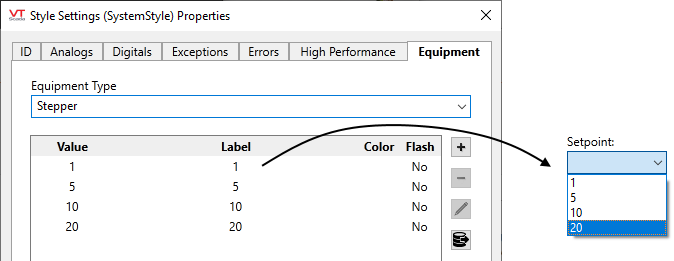Style Settings Tags
Not counted towards your tag license limit.
Style Settings tags provide a single point of configuration for many display characteristics, helping to ensure that your pages have a consistent visual style. For example, your industry may specify that a digital value in state 0 (off) should be shown in red, and state 1 (green) should be shown in green. In other industries, the opposite is true, or shades of gray might be used. For widgets that obey the Style Settings value, you need only set your preferences once, and all displays will use a consistent format.
Not all widgets recognize or use the Style Settings tag.
Style Settings tags can be opened from the Tag Browser and also, many widgets and most tags can be configured to use a Style Settings tag and have a direct link (see following image). In the event that both a widget and the tag linked to it are configured with different Style Settings tags, the configuration of the widget takes precedence over the configuration of the linked tag.

"System Style" is the default, included with every copy of VTScada
Many widgets have a similar configuration. Note that this is not available in all widgets.

Style Settings choice in a widget. "No tag selected" means "whatever the I/O tag uses".
One default Style Settings tag, "System Style", is included in every new VTScada application. It will be used by every style-aware tag that has not been configured to use an alternative selection, including no Style Settings tag.
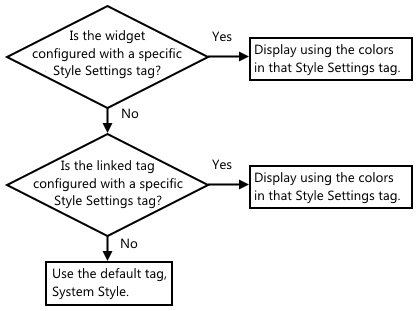

For Digital and Discrete I/O tags, use the following guide:
* If the linked tag has an Equipment Type and the Style has a definition for that type, then those colors and labels are used.
* Otherwise (at least for Digitals), the colors for the data type are used.
Troubleshooting:
- This object that I've drawn doesn't change with a style setting.
Does the tag have an Equipment Type? Equipment overrides basic tag type. for example a plain digital I/O will use the style defined under the Digitals tab, but the same I/O with an Equipment Type of Pump will use the style defined under the Equipment tab. - I don't see how to link this object to a style setting.
Style Settings are used only by certain widgets. They cannot be used with text, pipes, images, shapes or with widgets that aren't designed to use a Style Setting. It is possible to animate any property of any object, using an expression or a linked tag's value, but that is not the same as using a Style Setting tag.
Every widget's description states whether it can be used with a Style Setting. Also, widgets that can use a Style Setting are marked with a star in the table of contents.
Style Settings properties ID tab
The ID tab of every tag includes the same common elements: Name, Area, Description, and Help ID.
Name:
Uniquely identifies each tag in the application. If the tag is a child of another, the parent names will be displayed in a separate area before the name field.
You may right-click on the tag's name to add or remove a conditional start expression.
Area
The area field is used to group similar tags together. By defining an area, you make it possible to:
- Filter for particular tag groups when searching in the tag browser
- Link dial-out alarm rosters to Alarm tags having a particular area
- Limit the number of tags loaded upon startup.
- Filter the alarm display to show only certain areas.
- Filter tag selection by area when building reports
When working with Parent-Child tag structures, the area property of all child tags will automatically match the configured area of a parent. Naturally, you can change any tag's area as required. In the case of a child tag, the field background will turn yellow to indicate that you have applied an override. (Orange in the case of user-defined types. Refer to Configuration Field Colors)
To use the area field effectively, you might consider setting the same Area for each I/O driver and its related I/O tags to group all the tags representing the equipment processes installed at each I/O device. You might also consider naming the Area property for the physical location of the tag (i.e. a station or name of a landmark near the location of the I/O device). For serial port or Roster tags, you might configure the Area property according to the purpose of each tag, such as System or Communications.
You may define as many areas as you wish and you may leave the area blank for some tags (note that for Modem tags that are to be used with the Alarm Notification System, it is actually required that the area field be left blank).
To define a new area, type the name in the field. It will immediately be added. To use an existing area, use the drop-down list feature. Re-typing an existing area name is not recommended since a typo or misspelling will result in a second area being created.
There is no tool to remove an area name from VTScada since such a tool is unnecessary. An area definition will exist as long as any tag uses it and will stop existing when no tag uses it (following the next re-start).
Description
Tag names tend to be brief. The description field provides a way to give each tag a human-friendly note describing its purpose. While not mandatory, the description is highly recommended.
Tag descriptions are displayed in the tag browser, in the list of tags to be selected for a report and also on-screen when the operator holds the pointer over the tag’s widget. For installations that use the Alarm Notification System, the description will be spoken when identifying the tag that caused the alarm.
The description field will store up to 65,500 characters, but this will exceed the practical limits of what can be displayed on-screen.
This note is relevant only to those with a multilingual user interface:
When editing any textual parameter (description, area, engineering units...) always work in the phrase editor. Any changes made directly to the textual parameter will result in a new phrase being created rather than the existing phrase being changed.
In a unilingual application this makes no difference, but in a multilingual application it is regarded as poor practice.
Help Search Key
Used only by those who have created their own CHM-format context sensitive help files to accompany their application.
Style Settings properties Analogs tab
If your I/O tag has an Equipment type, configure the style using the Equipment tab rather than this tab.
Fields in the Analogs tab of this tag are used to set colors and labels for LCD widgets.
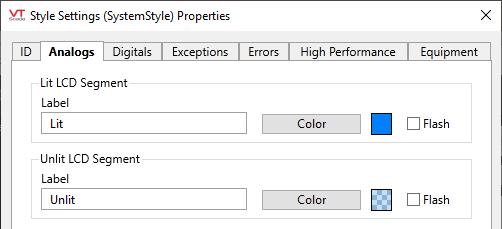
Lit LCD Segment
When an LED indicator widget is used for a numeric display, the lit portion will have this color.
Unlit LCD Segment
When an LED indicator widget is used for a numeric display, the unlit portion will have this color, typically using an opacity value less than one.
Style Settings properties Digitals tab
If your I/O tag has an Equipment type, configure the style using the Equipment tab rather than this tab.
The Digitals tab of this tag sets color and text for equipment / status widgets, indicator-lights and other style-aware widgets for digital tags.
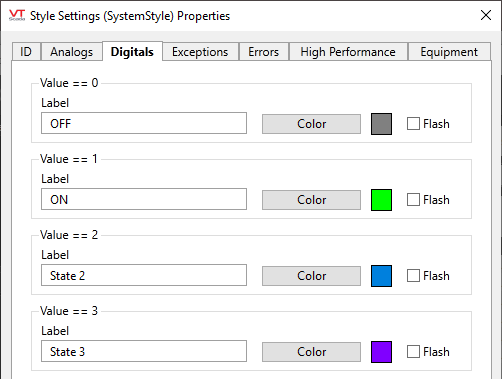
The text parameter is used only by widgets that recognize the Style tag and that include text.
Value == 0
Set the text and color of the text, displayed when the associated tag is in the zero state.
Value == 1
Set the text and color of the text, displayed when the associated tag is in state one.
Value == 2 and Value == 3
For digital tags that use two address fields, and therefore can display up to four states, this label and color will be displayed when the associated tag is in state two.
Style Settings properties Exceptions tab
Exceptions refer to alarm states, as displayed by those widgets that have alarm indication features. Note that these do not reflect the priority of the alarm.
The exception indicator will vanish when the alarm normalizes, even if that alarm has not been acknowledged. You can change this behavior by changing the property "AlarmWidgetsShowUnackedNormalAlarm" in the application's properties, setting the value to 1. (This property affects most widgets that indicate alarms using the Style Settings properties, with the exception of the Alarm Priority Indicator, Alarm Priority Box, and high performance graphics widgets.)
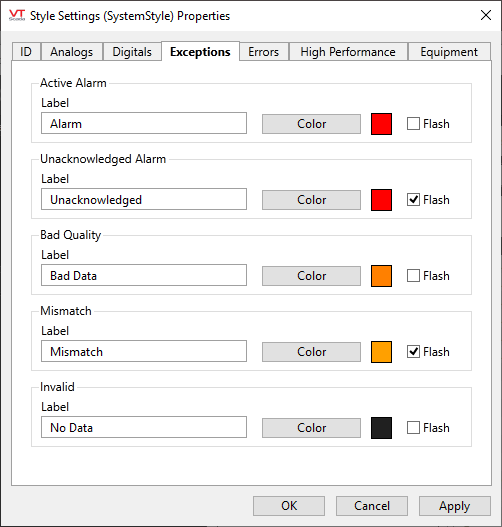
Active Alarm
Set the text and color of the text, displayed when the associated tag has an active alarm.
Unacknowledged Alarm
Set the text and color of the text, displayed when the associated tag has an unacknowledged alarm.
Bad Quality
Custom programming, using the VTScada scripting language, must be done to make use of the Quality field of a tag. If the associated tag is using the Quality field, the associated widget will use the label and color set in this field to indicate a bad quality value.
Mismatch
For output tags, if the feedback value for the associated tag does not match its current value, or value last written, this text and color will be displayed on the associated widget.
Invalid
Set the text and color of the text, displayed when the associated tag is in an invalid state. Invalid states usually indicate a break in communications, whether due to faulty configuration or communication.
Style Settings properties Errors tab
The label parameter is not used by any VTScada widgets in this version.
The value property of tags in the ports group, drivers group, the Modem tag and the SMS Appliance tag, will indicate whether that tag is in an error state. When drawn using a Status Color Indicator or Indicator Light widget, the tag's value, which indicates the error state, will be shown using the colors and labels configured here rather than the colors defined in the digitals tab.
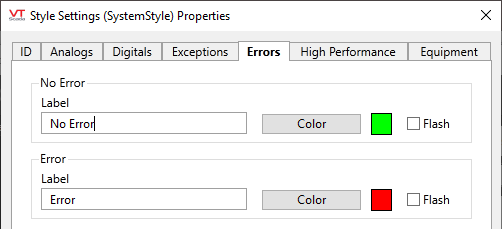
No Error
Color to be used when the linked tag is not in an error condition.
Error
Color to be used when the linked tag is in an error condition.
Style Settings Properties: High Performance tab
Properties set here control colors used in high performance HMI graphics such as the Spider Plot widget and HP Analog Bar.
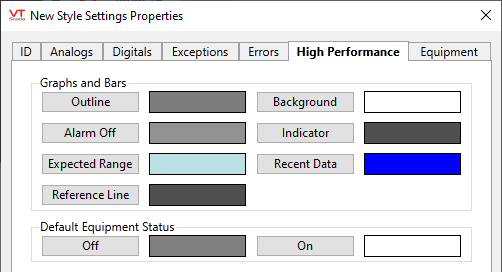
The Default Equipment Status colors (Off and On) can be used by Equipment / Status Color indicators. If enabled within the widget, these colors will be used instead of the On / Off colors for the linked digital I/O tag.
For Equipment / Status Color widgets, when the High Performance option is selected, alarm (exception) colors are NOT shown. Use an Alarm Indicator widget instead.
Style Settings properties: Equipment tab
Used by I/O and Calculation tags that have been assigned an equipment type. Typically, those tags should be Digitals or Enumerated types, which have well-defined values that you can map to style settings. Analog ranges cannot be mapped to individual style settings.
To define a label for Invalid, use the Exceptions tab. This will be used by all tags / widgets and cannot differ by equipment type.
You are free to create as many equipment types as you need, and you may do so from within either an I/O tag on the ID tab or a Style Settings tag on the Equipment tab. The instructions are the same in both cases:
- Place the cursor in the Equipment Type field.
(It does not matter whether the field is blank or shows an existing type.)- Type the name of your new equipment type.
- Press the [tab] or [Enter] key on the keyboard.
- Click the Apply button.
The new type is saved.
If the field had shown an existing type before you started, it is not changed.
You can match properties of label, color and flash to any value that the tag may have. Refer to the following screen capture of the default configuration for a Pump type. A value of 0 in the tag maps to the label "Stopped" and the color gray. A value of 1 in the tag maps to the label "Running" and the color green.
If the tag has a value that is not included in the list, nothing is shown in the widget.
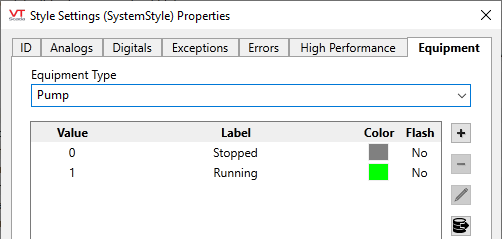
Use the tools along the right side (plus, minus, pencil, import) to add, remove, or edit entries in the list. The last tool in the list, import, gives you the ability to import entries from a comma-separated value (CSV) file. (See instructions later in this topic.)
After selecting or creating an equipment type, create settings for the possible states by clicking the Add button  . This will open the Add Value dialog. If you attempt to define the same value twice for a given equipment type, you will be warned to choose another. You will not be warned if you leave a value out of a series, therefore it is best to enter values in order from lowest to highest. Values may be numeric or text.
. This will open the Add Value dialog. If you attempt to define the same value twice for a given equipment type, you will be warned to choose another. You will not be warned if you leave a value out of a series, therefore it is best to enter values in order from lowest to highest. Values may be numeric or text.

Note that the default color is transparent.
CSV Import
When there are many possible values or states, you can automate the process of populating the equipment definition by importing labels and values from a comma-separated value (CSV) file. The file must be in the form:
Value,Label,Color,Flash
Where:
- Value may be any value, numeric or text.
Any existing entries with the same value will be over-written. - Label is text and may by any label.
- Color is optional and may be either a number from the VTScada color palette, or an hexadecimal value in the form
<aaRRGGBB>. If not provided, the default is black. - Flash is optional, defaulting to "no flash". If provided, this must be a 1 specifying On, or a 0 specifying Off.
Use
If the equipment type is used for an input tag, the label for each matching value can be displayed by using an I/O Multi-Text widget.
If for an output tag, then the values and matching labels can be used to configure the selections available in a Droplist Widget.
